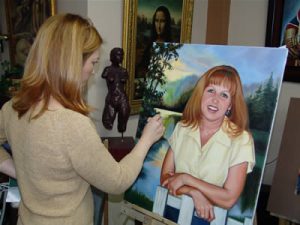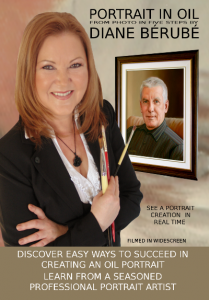My Technique
Oil Portrait technics by Diane Bérubé Realist Portrait Artist
 After making a precise drawing on the canvas, I make a wash with oil paint. With tones of brown very diluted with Liquin, I put in place shadows and general lights. I use shades of raw umber and titanium white. Then I let it dry for a night or a day. Then I start a first application of colour in the background and add the general colours of the clothes. I cover the entire canvas, composing and mixing colours as I go using only primary colours, blues, yellows and reds with white and brown. I leave it to dry a day or two, I then continue on applying skin colours on the facial areas while harmonizing tons and constantly comparing with the background. Because the skin tones of a character are always influenced by the surrounding environment and lighting.
After making a precise drawing on the canvas, I make a wash with oil paint. With tones of brown very diluted with Liquin, I put in place shadows and general lights. I use shades of raw umber and titanium white. Then I let it dry for a night or a day. Then I start a first application of colour in the background and add the general colours of the clothes. I cover the entire canvas, composing and mixing colours as I go using only primary colours, blues, yellows and reds with white and brown. I leave it to dry a day or two, I then continue on applying skin colours on the facial areas while harmonizing tons and constantly comparing with the background. Because the skin tones of a character are always influenced by the surrounding environment and lighting.
When the painting is done, I must leave it to dry for at least two days. Then I begin with the glazes which help with the refinement of nuances and details. There may be several layers of transparent glazed colours to achieve the infinite shades of a realistic portrait. This technique gives the work an aspect of three dimensions. Drying times between layers of glaze allow the canvas to be ready to varnish and frame within two to three weeks after ordering. Large works may require up to several months of work. Portraits painted from old black and white photos to reconstruct the character in colour also require more time to achieve, which leads to an increase in the cost of production of the artwork.
For customers who want a very textured work, with thick spatula and brush strokes, I use acrylic paint to paint the first stage of the work. The acrylic dries in four days, while the thick oil takes from 6 months to a year to completely dry. I then paint according to my oil painting technique described above over the textured acrylic base.
Pastel Technique
The pastel drawing is executed on Sennelier Pastelcard because it is the best pastel medium I know. It keeps the colour pigments in place and allows to make several overlays. Dry pastel is composed of the same colour pigment as paint except that it is powdery and compressed into a stick. It is applied on the drawing directly with sticks and mixtures are done with the fingertips directly on Pastelcard. The pastel portrait has an almost photographic appearance, with great detail and vibrant colours. It must be framed under glass to protect it. It will always keep its colours because all the materials used are acid-free.
Charcoal Portrait
The charcoal drawing is executed on pastelcard or velvet paper. The pastelcard allows me a more contrasted and defined effect; velvet paper produces a softer effect. With different types of charcoals, I use gray and white pastels. The style of black and white is classic and very popular. It makes the character timeless, as in black and white cinema. The charcoal must be framed under glass like pastel.
For those who would like to learn my technique, I have made a teaching DVD.
Just click on the image bellow
